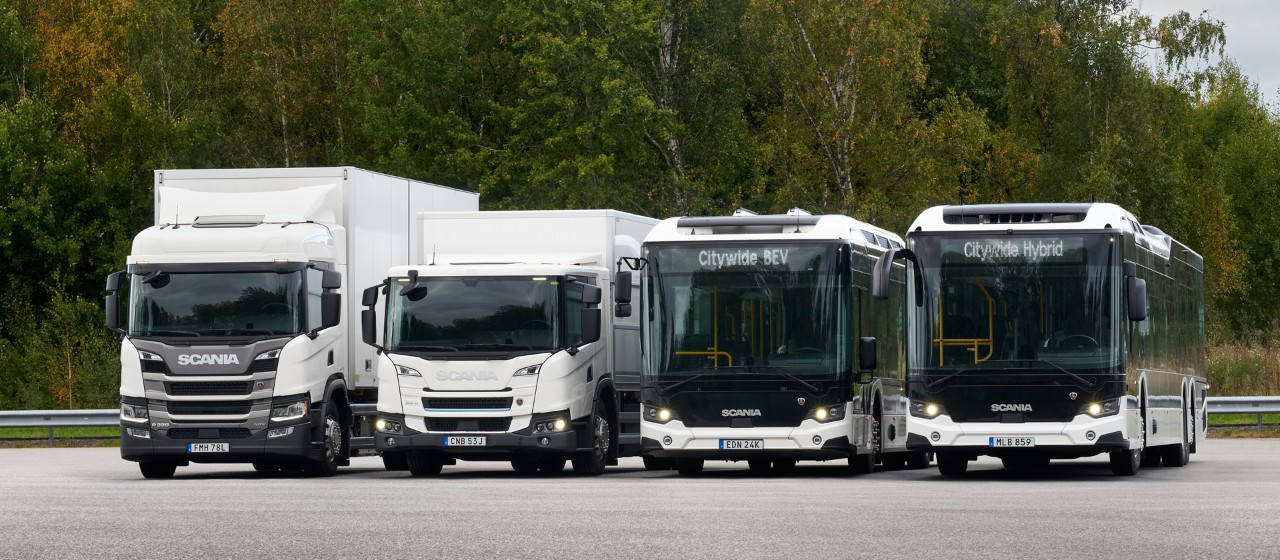
Scania’s electrification roadmap
24 NOVEMBER 2021
Scania is ready for the transition to zero emission vehicles. We have a plan – an electrification roadmap that will guide us and ensure we have a new electrified product available annually. We already have fully electric trucks and buses on the market that have a range of up to 250 km per charge, and we can expect an expanded range of up to 500 km in four to five years.
The need for transport is constantly increasing, as this is something society depends on. But profit margins in the transport business can be slim, making change difficult. At the same time, a significant portion of global CO2 emissions, around a quarter, comes from transport. We know that we are a part of the problem, but that means we must be part of the solution.
In terms of reducing emissions with electric vehicles, things are happening faster than we expected just a couple of years ago. There are three main reasons for this:
1. Sustainability demands are increasing – not only regarding CO2 emissions but also local air and noise pollution
2. It is profitable for the customer – due to the costs of energy and road fees, electric vehicles are becoming competitive more quickly
3. The technical conditions are here – battery capacity and rapid charging technology are improving rapidly
The commitment
Scania has signed up to do our part to keep global warming under 1.5 degrees – we have approved Science Based Targets for 2025 and we have signed The Climate Pledge, committing to be fully net-zero by 2040. These commitments cover emissions from both our own operations and from when our products are used by our customers – where 96% of the total emissions from our operations and products are generated.
To make this shift possible, we offer a wide range of electrified and hybrid vehicles, as well as the widest range of biofuel-compatible engines. While biofuels will be important as transition fuels in operations considered difficult to electrify – such as timber transports, remote transports, heavy and long-haulage transports – we are also working to electrify these segments and testing electric vehicles with early-mover customers.
Our battery electric vehicle (BEV) and plug-in hybrid (PHEV)
Scania has launched a BEV and a PHEV for urban operations. The 29-tonne BEV has a range of 250 km when charged for 90 minutes. The 29-tonne PHEV has an all-electric range of 60 km when fully charged.
The roadmap
- In 2022, Scania will release an updated, 36-tonne PHEV, with an all-electric range of 60 km after 30 minutes of charging.
- In 2023, we will have heavier BEV trucks capable of running for four hours with 40 tonnes gross weight or three hours with 60 tonnes gross weight, intended for regional transport.
- In 2024, long-distance electric trucks, adapted for fast charging during drivers’ 45-minute rest breaks, will enter the market. These will be capable of running between four and four and a half hours, depending on whether the vehicle weighs 40 or 60 tonnes.
- By 2025, we will be able to electrify most operations, including construction, mining, long haulage and timber trucks. This is also the year when 10% of our volume sales will be electrified. Looking to the second half of the decade, we will have the technical capability to electrify more or less any application; however, it will not yet be profitable for all customers in all markets. But by 2030, 50 percent of our total vehicle sales volumes should be electrified.
For this to happen, we must have access to charging infrastructure and renewable electricity. As a result, infrastructure investments and partnerships for battery electric vehicles remains a priority for us.
"Knowing what's coming and when, means that we can help the customers plan far ahead – which is hugely important when it comes to things like charging infrastructure that can take substantial time to implement, says Fredrik Allard, Senior Vice President for e-mobility. “Through strong partnerships and alliances with stakeholders in not just the traditional transport industry, but also when it comes to things such as energy infrastructure and green power, we intend to not just follow this industry transition, but to be at the forefront of it. Driving the shift as we like to say.”
What we provide and how it is possible
We want to provide the most efficient electric vehicles possible. Because we have in-house development and manufacturing of all core components, we believe this is possible. We also use connected vehicle data to design the batteries and optimise systems, with battery cells specifically adapted for heavy vehicles.